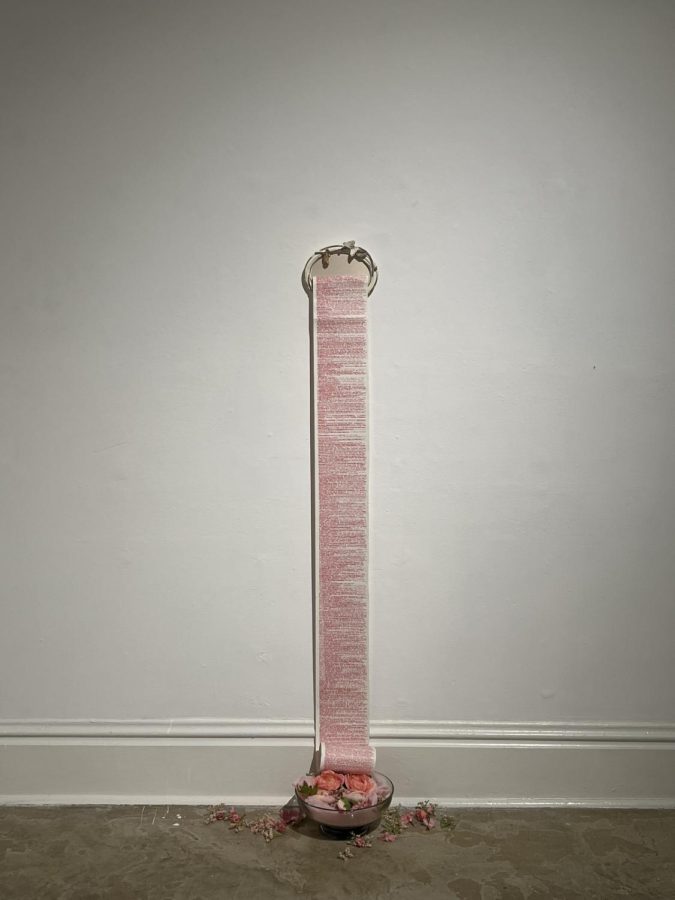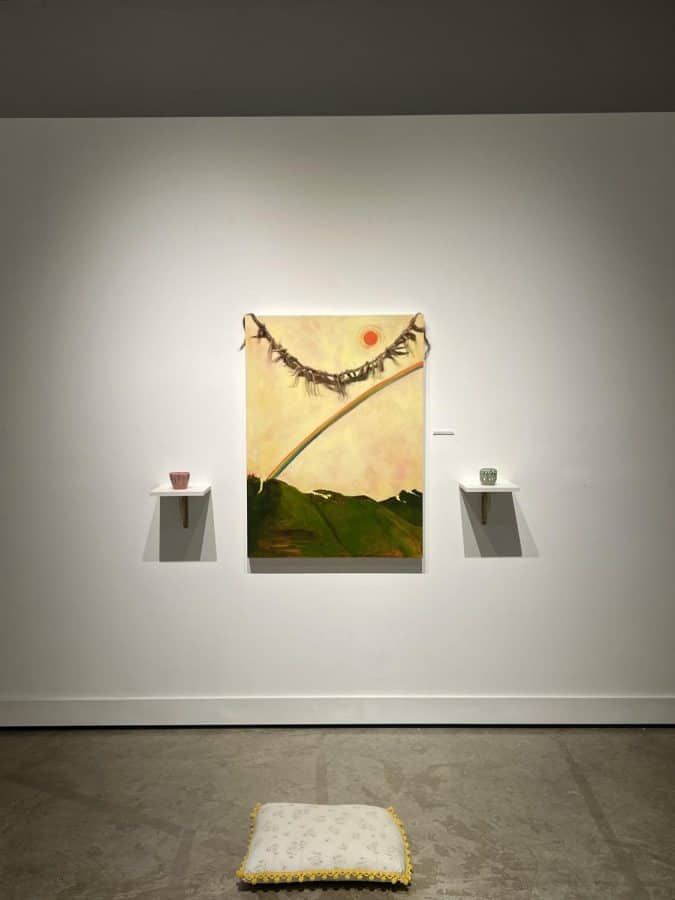Kathy Rodriguez’s ‘Ruminations’ Opens Sella-Granata Exhibition Season
September 11, 2022
Sella-Granata Art Gallery began its fall exhibition season last Thursday, Sept. 8, with the opening of an exhibition from Kathy Rodriguez — a University of New Orleans instructor, art critic and TEN artists’ collective founding member.
The exhibition, entitled “Ruminations,” features 15 pieces of work, both two and three-dimensional, that follow a chronological journey of Rodriguez’s growth over the last few years.
Rodriguez said the exhibition developed out of a series of drawings she began after teaching in Rome during the summer of 2018.
She said that before that summer, she had been going through some “drastic personal changes,” and with the teaching position being a last-minute occurrence, she was anxious. However, after meeting many wonderful people, she felt at home in the city.
When she returned home, she started creating drawings with typewriter text, dyes, ground pigments and erased geometric circles that referenced the classical geometry that characterizes the artwork and architecture of Rome. This turned into a solo exhibition called “Making Room” in October 2018, which focused on the idea of eclipses and new beginnings.
“I felt like that work was about making space. … Making space to be comfortable within, acknowledging all of the extraneous stuff that was going on, but at the same time, I was creating room for myself to grow,” Rodriguez said.
For the viewers of “Ruminations,” the exhibition begins with a remake of the work from “Making Room.” Entitled “Teachable Moment,” this white chalk and black chalkboard paint on Masonite hardboard sits against the right wall at the gallery entrance in a black frame and symbolizes an erasure of past experiences to make room for the new.
Next to them sit three large, vibrant oil paintings that Rodriguez began working on after the pandemic: “Lake Pontchartrain Driving at Night,” “Bean Moon” and “International Space Station.” These paintings were inspired by 19th-century romantic landscape paintings and painters like Odilon Redon, Pierre Puvis de Chavannes, Joseph Mallord William Turner and Caspar David Friedrich.
The paintings display nature’s beautiful and overwhelming power through many sublime landscape paintings and depict memories of New Orleans that Rodriguez photographed while she and her husband were dating.
“I was reflecting on those moments and at the same time kind of reflecting on how I never thought this was possible for me that I would be in such a loving, supportive relationship,” Rodriguez said. “So, the paintings kind of explore that therapeutic territory and ideas of meditation, ideas about eclipses, which are new beginnings, new cycles.”
The landscape paintings are followed by another oil painting titled “The Pain Box (What I learned in Therapy This Time or I hit it over and over but less and less).” The painting focuses on the concepts Rodriguez learned about pain and grief in therapy. It features a full moon beside a broken heart sewn up with sutures of her and her husband’s hair that Rodriguez’s father — who, like most of Rodriguez’s family, is in the medical field — taught her to tie.
These oil paintings feature evocative brush strokes that give the viewer another aspect of the painting to meditate on.
Rodriguez said degrees of physical and visual texture are particularly important to her, and she likes playing with a sense of space, push and pull, and tension.
“Some things I want to emphasize more with texture and body. Some things I want to be very gestural, some things I want to be really tight and detailed,” Rodriguez said. “It’s very much about awareness of the body, about the gesture, about the energy that goes into making the mark of the color.”
From these paintings, the work transitions to two captivating three-dimensional pieces, which Rodriguez created for the viewer to immerse themselves in.
“Fare Well to the Flesh: Apocalyptic Landscape (The Day the Earth Caught Fire (1961) / Missoula on Fire 2007)” was initially made for a group show for Mardi Gras that Rodriguez painted based on memories of graduate school in Missoula, Montana.
It features two handmade candles, by Sarita Mahinay, that represent abundance and protection, Sarita on shelves on both sides of an oil painting that has a garland of hair and cat fur hanging over it, representing a decorative “leaving of the flesh.” Just below it sits a decorative pillow, with a pillowcase Rodriguez made from one of her grandmother’s pillowcases, inviting the viewer to take a seat, think and reflect.
She said the painting is about being as decadent as possible before sacrificing for the Lenten season, as well as climate change, and it takes some influence from 1961’s sci-fi apocalypse film “The Day the Earth Caught Fire” — a genre of film Rodriguez and her father share a love for.
“It’s kind of, like, very apocalyptic. … [Cormac McCarthy] writes a lot about apocalyptic landscapes, and I kind of took that idea, put a little rainbow on it, a symbol of hope and art historically. Rainbows are totally legit, like, you see a lot of them, especially in European romantic artwork,” Rodriguez said.
Next to “Fare Well to the Flesh …” is “High Anxiety,” a three-dimensional piece with an embellished, oval butterfly frame that sits against the wall with a red typewriter ink print in its center. On it, Rodriguez wrote psychiatric diagnoses, information her mother had kept since she was a teenager, information from the National Institute of Health websites and more, repeatedly typed over until it is almost illegible without intense focus from the viewer.
The tight scroll of white Strathmore rag paper, which is Rodriguez’s height when stretched out, unfurls like a tongue from the frame into an overflowing glass bowl of pink silk flowers and soft chiffon fabric.
“It’s like a moment of self-care and acknowledgment that these things are rough, but there is a softness that’s available,” Rodriguez said.
Followed by three typewriter prints, the show ends with another three-dimensional installation with the same name as the exhibition. It sits in the center of the gallery as a lone desk and chair with a manual typewriter on top, loose papers and Mary-Frances O’Connor’s book, “The Grieving Brain: The Surprising Science of How We Learn from Love and Loss.”
Rodriguez said the piece is an homage to the practice of rumination and that it brings a lot of concepts from the show full circle.
One of the focal points of the work is the book, which shares discoveries about what happens in the brain when people grieve and new concepts for understanding love, loss and learning.
“There’s a portion of that book that is about rumination, and I’d already decided on the title ‘Ruminations’ for the show, but when I read that, I was like, ‘Alright, this is legit,’ like, ‘I’m going to do this,’ so that turned into an installation,” Rodriguez said. “But yeah, rumination means chewing the cud, and you see it in Romantic literature, as a reference to walking through the landscape and thinking and sauntering. And these slow movements that allow for that regurgitation of different thoughts that kind of swirl around, and just letting them go, which is the goal of meditation.”
As the viewer ruminates on Rodriguez’s work throughout the exhibition, she hopes that, in the end, the viewer can walk away with a connection to the work.
“It doesn’t have to be good; it doesn’t have to be bad. You know, it’s like, if there is a kind of connection and like an internal dialogue that starts to happen with the work that brings me so much joy,” Rodriguez said. “And the term universal is really taboo, and I don’t like using it, but a familiarity with what I’m trying to convey is about the best I can ask for.”
She said she wants people to get close or stand back in order to see the nuances in the work, allowing their brains to engage in the creative process by connecting to their own experiences.
“I hope that this is a way for people to just take time for themselves and have an experience, you know, the nurturing Cancerian astrology that is like a huge part of me. Is that nurturing kind of like, emotional desire, like I want to mom you so much,” Rodriguez said.
“Ruminations” is open for viewing until Thursday, Sept. 22, with a gallery talk and closing reception on the final day at 5 p.m.






















